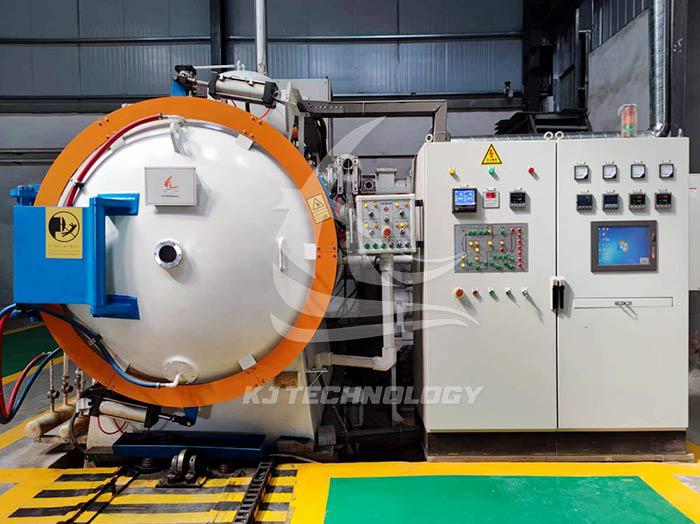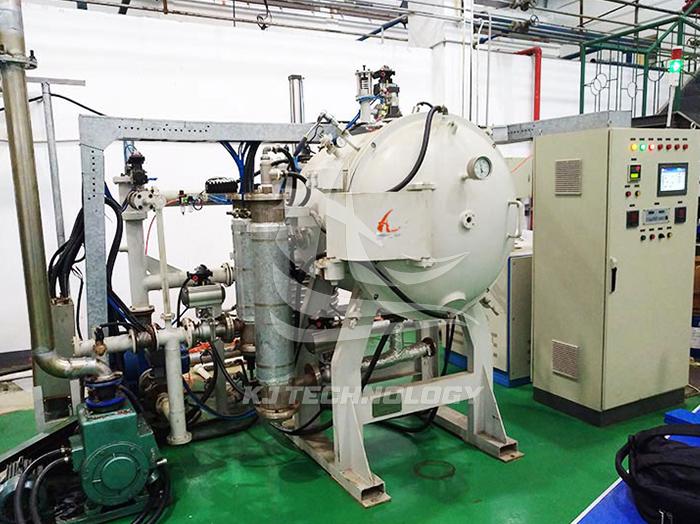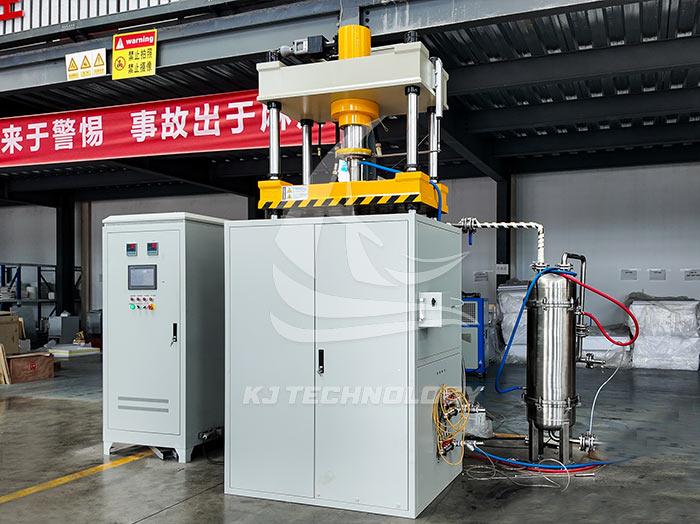Precautions for using large-sized furnace vacuum heat treatment furnace
 09-29-2025 Author: KJ technology
09-29-2025 Author: KJ technology
When using a large-sized furnace vacuum heat treatment furnace, comprehensive control is required from multiple aspects such as equipment operation, safety protection, process control, maintenance, and personnel management to ensure stable equipment operation, process quality compliance, and personnel safety. The following are specific precautions:
1. Equipment operation specifications
Preheating and no-load operation
After the first use or long-term shutdown, it is necessary to preheat the furnace body with low power (such as holding at 200 ℃ for 2 hours), eliminate moisture in the furnace, and avoid stress cracking caused by water evaporation at high temperatures.
No load test: After new equipment or maintenance, a no-load temperature rise test is required to check temperature uniformity (within ± 5 ℃), vacuum degree (≤ 1 × 10 ⁻ ² Pa), and whether each system (heating, cooling, vacuum pump) is running normally.
Loading and fixing
Workpiece placement: Large workpieces require specialized fixtures (such as multi-layer racks, rotating tables) to ensure stable center of gravity and avoid tipping or deformation due to thermal expansion during heating.
Spacing control: A gap of ≥ 50mm should be maintained between workpieces to prevent uneven temperature caused by thermal radiation obstruction.
Material compatibility: Avoid mixing low melting point metals such as zinc and lead with high-temperature workpieces to prevent volatile matter from contaminating the furnace.
Vacuum system operation
Vacuum pumping sequence: First, turn on the mechanical pump to draw a rough vacuum (10 ³ -10 ⁻¹ Pa), then start the diffusion pump or molecular pump to draw a high vacuum (10 ⁻³ -10 ⁻⁴ Pa) to prevent damage to the pump body during heavy load start-up.
Vacuum degree monitoring: Continuous monitoring of vacuum degree is required for sintering or annealing processes. If the leakage rate is greater than 0.5 Pa/h, the machine should be stopped immediately to inspect the sealing ring, observation window, or weld seam.
2. Safety protection measures
high-temperature protection
Furnace insulation: The temperature of the outer wall of the furnace may reach over 100 ℃, and warning signs should be set up. Wear heat-resistant gloves during operation.
Emergency cooling: Equipped with gas quenching or oil quenching system, it can quickly cool the furnace in case of sudden failure, preventing the workpiece from overheating and melting.
Vacuum safety
Positive pressure protection: When the pressure inside the furnace exceeds 0.1 MPa, the safety valve automatically releases pressure to prevent the furnace from bursting.
Observation window protection: Use double-layer quartz glass or polycarbonate sheet to prevent high-temperature splashes from penetrating and injuring people.
Electrical safety
Grounding protection: The equipment casing and heating element must be reliably grounded with a resistance of ≤ 4 Ω.
Leakage detection: Install a leakage protector with an operating current of ≤ 30mA and an operating time of ≤ 0.1s.
Gas safety
Inert gas filling: When breaking the vacuum, nitrogen or argon gas should be introduced first to prevent oxygen from entering and causing oxidation or explosion.
Hydrogen usage: If hydrogen annealing is involved, a hydrogen detector should be equipped, which will automatically alarm and cut off the gas source when the concentration is greater than 2%.
3. Key points of process control
temperature control
Segmented heating: For example, the annealing process can be divided into three stages: from 300 ℃/h to 500 ℃ (stress relief), from 200 ℃/h to 850 ℃ (complete annealing), and then cooled in the furnace to below 600 ℃ before being removed from the furnace.
Overtemperature protection: Set dual circuit overtemperature alarm. When the temperature of the main circuit exceeds the set value by 5 ℃, it will automatically shut down, and when the temperature of the backup circuit exceeds 10 ℃, it will be forced to shut down.
Vacuum degree matching
Sintering process: High vacuum (below 10 ⁻¹ Pa) is required to prevent oxidation, and annealing process can be relaxed to 10 ⁻¹ Pa.
Gas replacement: When filling with argon gas protection, it is necessary to first evacuate to below 10 ⁻ Pa, and then slowly fill with argon gas in three stages to atmospheric pressure to avoid gas flow impacting the workpiece.
Cooling rate control
Oil quenching process: The quenching oil temperature should be controlled below 80 ℃ to prevent cracking of the workpiece.
Gas quenching process: The nitrogen pressure needs to be stable, and the flow rate should be ≥ 15 m/s to ensure uniform cooling.
4. Maintenance and upkeep
routine inspection
Seals: Check the O-rings or fluororubber seals of the furnace door, observation window, and thermocouple interface every week, and replace them immediately if they are aged or damaged.
Vacuum pump oil: Check the oil level of the diffusion pump every month. If the oil becomes black or contains moisture, it needs to be replaced (it is recommended to use silicone oil or mineral oil).
Heating element: Use an infrared thermometer to measure the heating resistance value every quarter, and replace it if the deviation is greater than 10%.
periodic calibration
Temperature sensor: sent to the metrology institute for calibration every year, with an error range controlled within ± 1 ℃.
Vacuum gauge: Calibrate with a standard vacuum gauge every six months to ensure accurate readings.
Furnace cleaning
Decontamination treatment: After each batch, wipe the inner wall of the furnace with a dust-free cloth to remove metal powder or oxide residue.
Acid washing and descaling: Clean the cooling water circuit annually with a 5% citric acid solution to prevent scale blockage.
5. Personnel training and management
Operation qualification
Operators need to undergo professional training (such as vacuum technology, heat treatment process) and hold certificates before taking up their posts.
New employees must complete more than 20 batches of operations under the guidance of their master before they can work independently.
emergency drill
Organize an emergency drill every quarter to simulate scenarios such as vacuum leaks, overheating alarms, and fires, ensuring that personnel are familiar with escape routes and the use of fire extinguishers.
Record and Trace
Establish equipment operation logs to record temperature curves, vacuum levels, workpiece batches, and other information for quality traceability.
The modification of process parameters must be approved by the technical leader and archived for future reference.








